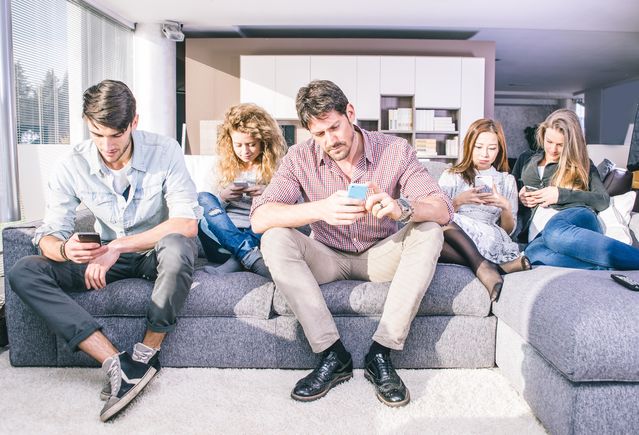Burnout
Are Americans Addicted to Screens—or Just Burned Out?
New research shows Americans sitting even more of the day in front of screens.
Posted June 28, 2019

We see it everywhere. People are sitting and looking at screens. They are on their phones–checking emails, looking at social media, playing games. They are sitting in front of a computer–working, watching videos, killing time. At work, people with cubicles or offices right next to each other send an email instead of standing up to talk in person. Why? They don’t want to interrupt the other person–they are likely on a screen in the middle of something. Or maybe it’s just easier to send an email than to get up and go talk. At the end of such an exhausting day, what do people do? They go home, sit on a comfy chair or couch, and binge-watch the latest Netflix or HBO series.
New research published in the Journal of the American Medical Association (JAMA) tracked sedentary behaviors and screen time in over 50,000 Americans from 2001 to 2016.
They found that Americans are sitting even longer every day in front of their screens–about one extra hour per day. In adolescents, sitting in front of screens increased from 7.0 hours per day in 2001 to 8.2 hours per day in 2016. For adults, sitting in front of screens increased from 5.5 hours to 6.4 hours per day during the same time period. This doesn’t include all sedentary or inactive behaviors. It only includes sitting in front of screens. People do lots of other things that don’t require physical activity. They sleep–that’s a big part of the day without activity. They sit in cars getting to places. They sometimes even sit at a table and eat without a screen in front of them.
Why are Americans spending even more time sitting in front of screens?
There are three popular theories:
- They are burned out
- They are addicted
- They are lazy
Let’s look at each of these.
Americans are burned out
Burnout is an increasingly popular catchphrase. Burnout is often focused on busy lives and busy work environments. It’s about always being on. Always needing to check work emails. Always having chores and errands to do. There is never time to just stop and relax. Stress levels are high.
A 2018 Gallop poll found that 23% of employees reported feeling burned out at work often or always, while another 44% felt burned out sometimes. So 67% of American workers endorsed feeling burned out at least some of the time.
How does this play into sitting in front of screens? It’s a question of the chicken or the egg.
When people feel burned out and overly stressed, they usually don’t have the energy to move. They just want to sit and relax. They want to take their mind off of the stressful things going through their heads. Phones, computers, and televisions can all serve this purpose. They can be good distractions. So maybe all of the sitting and screen time is a consequence of burnout.
The problem is that these distractions can take time away from getting your work, chores, and errands done. That can put you behind schedule and then add to your stress level. Another problem is that these devices are often connected to work. Many people have their work emails on their phone. This serves to constantly remind them of the work that is piling up for the next day. By staying constantly connected to work emails, work truly never ends. This may be the cause of some of this stress and burnout.
Americans are Addicted
Many experts believe that screens are addictive. They argue that phones are now designed to keep people “engaged.” This means hooked. The apps are designed to keep people on longer. People think more about their phones. They wonder if anyone sent an email. They wonder if anyone “liked” their latest social media post. They wonder if their friends just posted anything. It can feel like a way to stay connected and engaged with the world.
When people lose power to their phones, or God forbid, inadvertently leave their phones at home, they can get panicked. What if something important happens and they don’t have their phone? That could be catastrophic.
The same can be said for television shows. The programming has changed over the years. In the old days, there were newscasters reading the news. Just one or two people, and a fixed camera angle right in front of them. Nowadays, there are never-ending changes in the angles at which we see media and never-ending clips to break up the monotony of a single person just reading the news. All of this, and more, with one purpose in mind–to keep us “engaged.”
Americans are lazy
Finally, the last hypothesis for all of this sitting and screen time is simple–Americans are increasingly lazy. They don’t exercise enough. They overeat and get fat. They complain about workloads that people used to be able to do just fine. They complain about stress and burnout, and always being busy, but they really don’t have more to show for their lives. They increasingly just want to sit, play games, watch shows, go on social media, and then complain about everything that they have to do.
Should you do something about this?
In the end, you have to decide. Here are your options.
- Do nothing. You can go along with the crowd. Everyone else is doing it. You now have a study to support that.
- Do something. Why?
- There is abundant evidence that sedentary behaviors are associated with poorer health. Moving your body has innumerable health benefits – weight, mood and cognitive benefits, and prevention of all sorts of horrible diseases.
- There is also emerging evidence that screens do not replace real human interactions. Americans are increasingly lonely despite all of these electronic forms of “connection.” This can lead to higher rates of depression. Life can really be awful when you’re depressed. It turns out that loneliness and depression also affect the rest of your body and can lead to a whole host of physical problems. Life is better with real people, not screens.
What to do
- Track your time on screens. This can be eye-opening. Some smartphones are now offering apps to do just this, at least in regards to your phone screen time. Keep a log of how much time you are sitting in front of a screen–computers, televisions, and your phone. Sometimes, just knowing this information will be enough to motivate you to change.
- Come up with other ways to distract yourself or soothe yourself when you are stressed. If a phone or the television is your instant remedy to a stressful day, come up with some ideas for other things you can try.
- Take a walk.
- Get together with someone–a friend, a roommate, or family member. Come up with something to do other than screen time.
- Get back to a hobby that doesn’t involve screens. These are increasingly rare things.
- Get some of your chores or errands done. Clean your room. Organize that stack of papers. Catching up on things that you need to do can make you feel great and reduce your stress.
- Try to disconnect, even for one or two hours per day. Be mindful of how you feel. If you notice extreme discomfort and restlessness, take it as a sign that you may have a problem.
- Take a walk.
- Get together with someone–a friend, a roommate, or family member. Come up with something to do other than screen time.
- Get back to a hobby that doesn’t involve screens. These are increasingly rare things.




